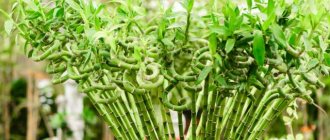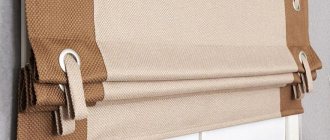Bamboo is a fast-growing perennial plant that grows wild in tropical and subtropical zones of Asian countries. It is incorrect to call the plant a tree; it is a member of the cereal family. In temperate latitudes it is grown in winter gardens and apartments.
In southern latitudes it is cultivated in open ground. Due to its active growth and ability to form a strong trunk, common bamboo has become a symbol of endurance and fortitude.
Description of bamboo
The stems of the plant are correctly called culms. They quickly become woody and branch only in the upper part. Under natural conditions, shoots grow up to 50 meters. The leaves are long, lanceolate. The spikelet processes in some species are located singly, in others they grow in groups. Bamboo blooms rarely, after 10 or more years. After ripening, the grains die off completely; only under favorable conditions does a living root remain. A distinctive feature of the plant is the simultaneous flowering of most shrubs in one area.
Bamboo has been used as a building material for a long time. The hollow, light stem (straw) is valued for its decorative properties; it is often used to create original interiors.
About the history of appearance
Bamboo is widespread in southern latitudes. It can be found in the tropical rainforests of Asia, Australia, Africa and South America. In its historical homeland, the bush is used as medicine or building material. In some areas it is actively consumed as food.
Homemade bamboo
In Europe and Russia, the plant began to spread thanks to the practice of Feng Shui. It symbolizes all the elements at once:
- Tree (the plant itself);
- Water (used for irrigation);
- Earth (pebbles, in which it is recommended to grow it);
- Metal (a flower pot is placed on it);
- Fire (symbolized by a red ribbon tied to the stem).
Later, the plant began to be used in room decoration, since its stems can be used to form various decorative elements, and it itself can be used as a natural room divider.
Types and varieties of bamboo
Among the many types, several are the most popular:
- Sasa is grown in Japanese gardens; there are dwarf and long-growing varieties, the height of the stems is from 25 cm to 2.5 meters. The leaves of Kuril saz are up to 13 cm long and reach 25 mm wide. Saza Nebulosa resembles a palm tree, the Vichi variety has a golden hue.
- Fargesia or Chinese bamboo is a group of medium-sized plants. The length of the sheet plates is up to 10 cm, width is up to 15 mm.
Up to 40 types of fargesia have been sectioned for home cultivation and winter gardens:
- The brilliant one tolerates frosts well, overwinters painlessly in open ground, and when the stems become lignified, they acquire a pleasant dark brown color;
- The New Collection is valued for its exterior: a dark cherry trunk with a purple tint contrasts with lush greenery;
- McClue grows up to 3.5 meters high, the variety is used for linear plantings, camouflaging fences, trellises;
- Eisenach, Great Wall - varieties of bamboo with small thin dark green leaves, these varieties are used to create hedges;
- Simba, Jumbo, Bimbo are low-growing varieties for indoor growing.
Phyllostachys is a tall type of bamboo with short internodes, flattened or grooved colored stems:
- black (stems begin to darken after two years of growth);
- with golden grooves and purple thickenings;
- light blue, exotic color begins to appear when the shoot becomes stiff in the second year of life, this heat-loving variety is used in landscape design;
- green, not all varieties of bamboo change the color of the stem during growth;
- yellow-brown, this contrast traditional for bamboo is often combined with a different shade of internodes.
Pleioblastus are dwarf varieties, among which there are variegated ones. The shrub is suitable for home growing.
A little about the plant
Indoor bamboo or Dracaena Sandera is a flower that has a bare stem and several leaves at the top. The trunk of the plant can be either straight or bizarrely curved. The bamboo varieties are usually found in bright green varieties, but sometimes grow with straw-yellow stems. Interestingly, indoor bamboo darkens when exposed to bright sun for a long time.
This plant not only decorates the interior, but also brings good luck - this is exactly what the ancient Chinese science of Feng Shui believes. Those who believe in omens and adhere to home planning according to Feng Shui, definitely try to acquire a Sander dracaena.
Features of growing bamboo in open ground
Cold-resistant types of bamboo grow in mid-latitudes and tolerate frosts down to -20 °C. For plants on the site, choose well-lit areas protected from the wind. In winter, snow should remain on the plantings; if the wind blows it away, the bamboo will freeze.
The plant is replanted from April to June, during the phase of active root growth. The soil needs to be loose and light. On clayey, heavy, poor soils, bamboo will not take root; it will begin to wither and die quickly. The soil is required with a neutral reaction or slightly acidic. It is advisable to use nutrient soil with a high humus content.
Stem formation
Stores often sell Dracaena Sander with spectacularly twisted trunks, sometimes forming an intricate geometric pattern. Experienced florists can achieve this effect under special conditions. But the dracaena stem is very flexible and elastic, which means that nothing and no one prevents the owner from trying to twist the bamboo trunk on his own.
You can do this in several ways:
- Place the stem in a plastic tube of the desired shape, which is removed after a few weeks.
- Form the desired bend using wire.
- Place the plant in an opaque box with folding walls that can be opened one at a time. The plant will begin to reach for the light and bend in the right direction.
It should be understood that after the formation of the trunk, the dracaena will continue to grow in the vertical direction.
Planting bamboo in open ground
It is recommended to prepare pits for spring plantings in the fall. They are made deep, up to 40 cm. The soil removed from the hole is mixed with humus in a 1:1 ratio. For winter, the planting hole is filled to only 1/3 of the depth, making a small mound. The rest of the soil is placed next to the hole. If it is not possible to prepare a place for planting in the fall, before planting the bamboo, water the hole well, leave it for 3-4 days, and allow the soil to settle.
Before planting, bamboo is specially prepared: the earthen ball of the plant is well soaked with water, completely immersing the pot in water. Leave for at least 2 hours. After this, the plant is carefully removed in an inclined position so as not to damage the roots. The latter are straightened, bamboo is planted, and covered with soil. Then pour water on it. After planting, the soil must be compacted, pressed down with feet so that there are no voids, only the top 5 cm are left loose.
Caring for bamboo in open ground
Agricultural technology for growing bamboo boils down to regular watering, fertilizing, and thinning so that the shoots do not interfere with each other. Each point is worth saying in more detail.
Watering
After planting, the cuttings need plenty of watering for the first few weeks. Only with frequent precipitation is the soil not additionally moistened. To preserve moisture, the soil around the young seedlings is sprinkled with dried humus, the earth warms up better. If it is not possible to frequently water young plants, the soil around them is covered with a dark film; when it is heated, water begins to rise from the depths and flows to the roots. In summer, with heavy dew, during rains, watering is reduced. Adult plants are moistened no more than 2 times a week (taking into account precipitation). If groundwater is close to each other, it is necessary to take an individual approach to the irrigation regime. When water stagnates, the leaves will begin to turn yellow. Between waterings, it is advisable to regularly loosen the soil to a depth of 5 cm.
https://www.youtube.com/watch?v=uxpQwBL3DuE
Trimming
Sanitary spring pruning involves removing damaged, twisted, frozen stems. Dense plantings are thinned out to allow the sun to penetrate deeper. When cutting, the stem is removed at ground level, without leaving a stump, or at a node. The stem cut off above the internode begins to grow back and will have to be cut off again. In the fall, no more than ¼ of the shoots are removed; the cut stems are usually left to overwinter in plantings and are used to create winter shelters that protect against frost.
Top dressing
In the spring, organic matter is added to stimulate active growth. In addition to nitrogen fertilizers, mineral fertilizers are used, the optimal ratio of phosphates, nitrogen, potassium is 3:4:2. In autumn, the volume of phosphorus is increased (4:4:2). The soil is loosened, dry granules are embedded in the soil to a depth of 3 cm, fertilizing is applied at the rate of 1 tablespoon (standard box) per 1 square meter.
Wintering
To preserve the roots during frosts in areas with little snow, the tree trunk circle is covered with a layer of mulch from 5 to 10 cm. For these purposes, dried wood shavings, hay or dry grass are used. Some gardeners cover bamboo with dry leaves. In this case, it is advisable to first treat them with insecticides. For snow protection, dry branches are used; they are stuck into the ground around the plantings.
It is important that bamboo survives the first winter, it is the most difficult for the plant. The trunk of heat-loving varieties dies at -17 °C; temperatures below -8 °C are not recommended for the root system. With a 15-centimeter layer of snow, the plantings will not be afraid of frost.
Caring for indoor bamboo at home
Growing indoor bamboo is in many ways similar to cultivating it in open ground. For convenience, the care algorithm is summarized in a table.
| Factor | Description |
| Location and lighting | Florists recommend placing bamboo on windows facing east or west; diffused light will be provided by a mesh curtain. If there is not enough sun, the plant will shed its leaves. |
| Temperature | The optimal growth regime is from +18 to 25 °C; the shrub tolerates high temperatures on summer days without stress; a sharp difference between night and day temperatures is undesirable. |
| Priming | Bamboo is not fussy; soil for any flowers, melons, tomatoes, or universal soil is suitable for it. Drainage is placed at the bottom when planting. |
| Capacity | It is advisable to choose a clay pot so that it can breathe. It is important to immediately choose a deep and wide container; the plant needs space. |
| Watering | The earthen lump should not dry out; it is moistened as it dries. Young shoots are watered abundantly only in the first month of growth. In winter, it is important to avoid stagnation of water. |
| Humidity | It is advisable to wipe bamboo leaves weekly to prevent dust from accumulating on them. Wet spraying is carried out infrequently; only in the evenings after hot days is the plant allowed to rest from the heat. |
| Top dressing | The whole complex of minerals and organic matter is required. It is advisable to choose fertilizers for dracaenas; if they are not available, it is permissible to use universal Agricola for indoor plants. |
Mr. Summer Resident informs: ways to grow bamboo at home
At home, the plant develops well in water. It is enough to change it once a week. Indoor varieties are unpretentious, they quickly gain weight and produce layering. It is allowed to add growth stimulants and fertilizers to the water (1/3 of the recommended amount so that there is no stress for the sprout). In indoor conditions or in a winter garden when grown in soil, bamboo stems reach a height of 2 meters. In a short time, flower growers create real tropical thickets. It is important to feed the crop in a timely manner and not let the water stagnate.
Plastic is not recommended for growing; it is better to choose glass or stainless steel containers of large volume; it is acceptable to use tall jugs. The vessels are placed near a window or light source. The plant gives good growth under a phytolamp. Water for bamboo shoots is first left to stand in an open container so that the chlorine evaporates.
Filtered or tap water is not suitable for the plant. The plant reacts very well to melt water.
Bamboo propagation
Indoor bamboo practically does not reproduce by seeds; it is too difficult and time consuming to grow seedlings in this way.
Cuttings are considered a more productive method of propagation. For these purposes, young shoots are used; they are cut in the spring from the main stem of a mature plant. The cuttings are separated without damaging them and planted in moist soil for rooting.
The composition of the soil is described above. Drainage is placed at the bottom of the planting container. In order not to have to replant the plant after 1-2 years, place the seedling in a large pot. The size of the cutting does not matter.
Cuttings are carried out together with transplanting the plant into a new container, 3-5 cm larger in diameter and depth than the previous one. It is better to do this in the spring. Cuttings adapt well and take root with proper care. Do not allow the wet ball to dry out.
Photo
In the photo below you can see what composition can be created from bamboo with proper care:
Diseases and pests of bamboo
Many plant species are resistant to diseases and are not affected by pests. Only a few are attacked by spider mites; they are attracted to lush greenery. To treat the affected stems and leaves, use any acaricides; they are diluted according to the instructions. Spraying is carried out in the evening, in calm weather, using personal protective equipment.
Sometimes scale insects appear; these small insects are afraid of plant or chemical insecticides.
Among fungal diseases, bamboo is characterized by spotted “rust” of leaves; it actively develops in cool, humid weather. For preventive purposes, the soil is treated with dry phytosporin. When spots appear, use fungicides.
Yellowing of leaves in autumn is not considered a disease; the plant sheds from 25 to 50% of its foliage before wintering. In summer, yellowing occurs from chlorosis, leaf blades become transparent and brittle due to lack of nutrients, with an excess of chlorine in the soil (soil salinity). After fertilizing with nitrogen fertilizers, the yellowness disappears.
Fertilizer
The young sprout does not need additional nutrition, because the soil is still rich in microelements. But as bamboo grows, it actively pulls them out, depleting the soil. Therefore, it is necessary to feed dracaena with both mineral and organic fertilizers. It is best to purchase special preparations that are designed for dracaena. They are ideal for bamboo. During the autumn and winter seasons, one dose of nutrients is sufficient. But during the warm season this needs to be done monthly.











